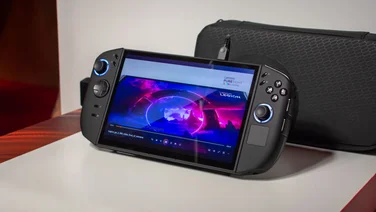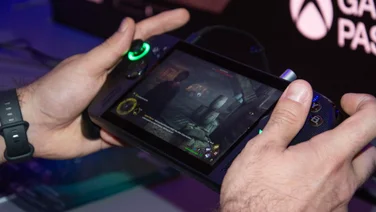To help us provide you with free impartial advice, we may earn a commission if you buy through links on our site. Learn more








- Incredibly easy to use
- Respectable specifications
- Suitable for gaming
- Far too expensive
- Microsoft store lacks content
- Build is less sturdy than similarly priced rivals
UPDATE: Windows Mixed Reality headsets have conspicuously vanished from the Microsoft store. The UK version of the store displays only one WMR headset (manufactured by Dell) at a reduced price, and it’s the same story in the US; currently, the only way to purchase the Lenovo Explorer – or most of the other WMR headsets – is via Amazon or eBay.
There’s no point speculating about why Microsoft has pulled the plug, because there are more important things at hand: namely, that the Lenovo Explorer is now going cheap. It’s possible to bag one second-hand on Amazon for as little as £235, which is to be frank a much more reasonable price for this plucky, entry-level VR headset.
Our original review continues below.
The Lenovo Explorer is one of several Windows Mixed Reality headsets that are pioneering a new, hassle-free way to enjoy virtual reality. VR might not have revolutionised the gaming industry just yet, but that doesn’t mean the hardware isn’t constantly being refined, and new applications for the technology are being found or created all the time.
These particular headsets require minimal setup: you’ll need a compatible Windows PC or laptop and very little else. This is because they aim to span the spectrum from education to entertainment by offering something that most VR headsets sorely lack: simplicity.
READ NEXT: Oculus Rift S review
Lenovo Explorer review: What you need to know








Technically speaking, the Lenovo Explorer is a mixed reality headset. In practice, this means very little: Windows Mixed Reality is mostly a concept, in spite of what the marketing may tell you. That’s not a bad thing necessarily, but it does mean that the Lenovo Explorer is fundamentally just a VR headset with a few compromises.
In the future, the Windows Mixed Reality platform will blend VR, AR (augmented reality) and everything in-between into one seamless package. The Lenovo Explorer is one of several partner-produced headsets that will provide the WMR service. The headsets vary from manufacturer to manufacturer, but the two motion controllers that come with the headset have been designed and made by Microsoft.
The package contains the headset, a pair of controllers and the necessary paperwork. There’s no external sensors, power bricks or complex cables: this is a VR headset for dummies.
READ NEXT: Our Oculus Go review
Lenovo Explorer review: Price and competition








It may compromise on features, but the Lenovo Explorer certainly doesn’t compromise on price. You’ll have to pay £400 for the complete package, which is the same RRP as the Oculus Rift and Oculus Rift S, and £100 less than the HTC Vive.
These are, of course, traditional VR headsets, complete with external sensors and a complicated setup process. If you shop around for Windows Mixed Reality (WMR) branded headsets, however, you’ll find that the Explorer is actually one of the cheaper options. ASUS’s equivalent WMR headset normally costs £430, as does the version produced by Dell. The cheapest mixed reality headset we’ve seen so far is made by HP and costs £380.
These headsets are fundamentally too expensive, but then again, virtual reality has never been cheap. If you’re looking to spend tiny amounts of money for a VR experience, you’ll have to consider smartphone-based headsets such as the Samsung Gear VR, which you can currently grab for as little as £40. Although, of course, you need a compatible Samsung phone to put in it, which should add several hundred pounds to that price if you don’t already have one.
Lenovo Explorer review: Design








The Lenovo Explorer headset is inarguably lighter and therefore more comfortable than the kind produced by the likes of HTC and Oculus. A single adjustment dial on the back of the head-strap allows you to find the most comfortable angle and fit; the goggles themselves can be lifted up and away from your eyes so you can take a breather without removing the headset entirely.
A 3.5mm jack hangs from one side of the Explorer headset, which is wonderful news for anyone wanting to use their own pair of headphones. In fact, you’ll have to use your own: the Explorer doesn’t come with its own audio device.
It’s an all-plastic construction, which explains why it’s so light. The Explorer feels immediately less sturdy and generally of a lower build quality than the likes of the Oculus Rift S or HTC Vive, so it’s all the more infuriating that it costs almost the same amount. That said, it doesn’t feel abysmally cheap, and the internal hardware helps to compensate for any sacrifices made on the design front.
The most frustrating thing is that keeping the moveable goggles in place is a struggle. The tilting visor is great, but it does mean that you’ll have to fiddle about a lot to achieve a good image quality, and heaven forbid you should need to look down whilst in-game.
The Explorer comes with two motion controllers that pair with your PC via Bluetooth. They’re not the most ergonomically friendly controllers in the world – seemingly designed for abnormally large hands – but they’re easy to use. I suffered briefly with connectivity issues during the setup process but found that replacing the batteries seemed to do the trick.
This is a bit of a downside: the motion controllers are each powered by two AA batteries and cannot be charged. Otherwise, though, the controllers work well, lighting up in a glittering LED pattern to allow the headset to track them accurately via two inside-out motion-tracking cameras. These controllers are designed by Microsoft and come with every Windows Mixed Reality headset.
Lenovo Explorer review: Display








Your VR experience is brought to you by two 2.89in LCDs with a field of vision of 110 degrees. The lenses offer a 2,880 x 1,440 resolution, which, when paired with a 90Hz refresh rate, is more than sufficient to produce a high-quality viewing experience.
The Oculus Rift, in comparison, features the same 110-degree viewing angles, with twin 1,200 x 1,080-pixel OLEDs and a 90Hz refresh rate. This is proof that the Windows Mixed Reality headsets are the real deal: the HTC Vive Pro offers twin AMOLEDs with a resolution of 2,880 x 1,600, but you’ll have to pay £800 for the privilege.
The only slight issue with the lenses on the Explorer is that they are a little narrow. This means you’re more likely to notice black rings around the edge of the display – it’s a little frustrating, but it’s also something your eyes adjust to pretty quickly. In addition, the so-called “sweet spot” (the position at which the image is clearest) of the Explorer is small, which means that you’ll need to do a lot of adjusting to get things looking good. User experiences will differ, though, and I didn’t find that I spent too much time re-arranging the goggles once I’d found the best viewing position.
READ NEXT: Our HTC Vive Pro review
Lenovo Explorer review: Performance








Perhaps the best thing about Windows Mixed Reality headsets is the ease with which they can be set up. The Lenovo Explorer connects to your PC via a 4m cable that plugs into HDMI and USB. Once plugged in, Windows will recognise the headset and begin the setup process automatically: the process is designed to be accessible for all levels of expertise, making the Explorer a great choice for anyone intrigued by the prospect of VR but unsure where or how to begin.
If you plan to play standing up, the WMR app requires you to “draw” a safe area around your PC within which you will be accurately tracked. The Explorer also caters to the gaming community, however, offering support for both keyboard and mouse and controller.
The setup process warns you if you’re missing any of the required components, or if your hardware is in any way incompatible. It warned me, for example, that my Bluetooth adapter wasn’t plugged in and even threw up a few exclamation marks at the RTX 2060 graphics card I have installed – the Explorer is designed for even the feeblest of Windows 10 laptops, but fortunately, more advanced hardware doesn’t seem to cause any major issues.
The Windows Mixed Reality desktop app launches into a virtual home, which serves as a good place to get to grips with the various controls. Wall-sized panes allow you immediate access to Skype, Microsoft Edge and various online stores. If you’ve purchased a VR-ready game from the Microsoft Store, all you need to do is press the Windows button on your motion controller and launch the game through the pop-up window.
The Microsoft Store offers a host of VR experiences to enjoy – from simple immersive world maps to more complex puzzle games. The offerings might be more limited than the options available on the Steam and Oculus shops, but the store hides a few aces up its sleeve in the form of games such as Minecraft, which is currently being ported to VR.








Microsoft’s store is, however, the least bountiful of all the VR game marketplaces, and as such you’ll notice a dearth of truly excellent gaming content. It’s a symptom of an illness that VR is only just beginning to shake off, and it feels like the Windows Mixed Reality headsets have been particularly badly afflicted. In other words: it’s hard to justify the £400 price tag based purely on potential usability.
But let’s be positive for a moment. The Explorer is a strong candidate for the kind of non-gaming experiences that might bring the technology into the mainstream. It’s a great fit for the classroom: many of the simpler experiences, such as visiting historical sites or a map of our solar system, are sure to dazzle anyone unfamiliar with virtual reality.
And despite the name, the Lenovo Explorer is a proper VR headset, which means it functions perfectly well as a gaming peripheral. Using the headset with Steam takes a bit of configuration, but we encountered no problems when using the headset with the SteamVR app.
Of course, you’ll need a PC that can handle the stresses of gaming in VR, but there’s nothing stopping you from using the Explorer to jump into a game such as Fallout 4 or Skyrim in full virtual reality. Just be aware that some games were designed with other headsets in mind, and so the controllers might function incorrectly.

Lenovo Explorer review: Verdict
The Lenovo Explorer is one of a new breed of VR headset. Windows Mixed Reality might be a confusing name for a simple premise, but these accessible headsets pioneer some interesting hardware that isn’t out of reach for the technologically challenged.
Lenovo has produced a well-designed, easy-to-operate headset that suits just about anyone with an interest in VR. You’ll have to look past the price tag, but if you can, you’ll find an intuitive entry-level headset with plenty to enjoy.
| Lenovo Explorer mixed reality headset specifications | |
|---|---|
| Display | 2.89in 2,880 x 1,440 LCD |
| Refresh rate | 90Hz |
| Field of view | 110 degrees |
| Supported software | Windows 10 Creators update, SteamVR |
| Dimensions (WDH) | 185 x 95 x 102mm |
| Weight | 380g |






